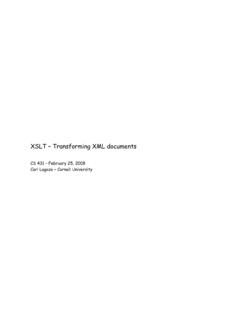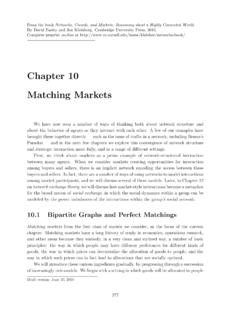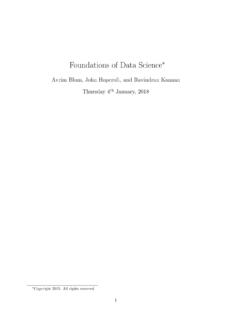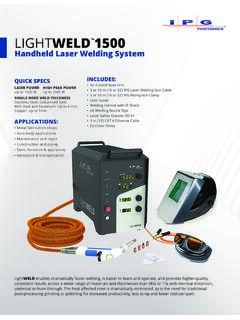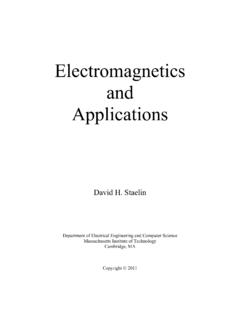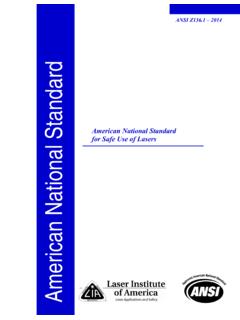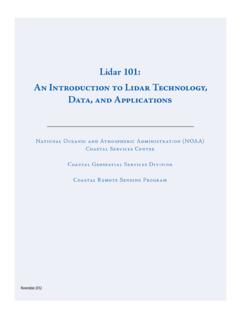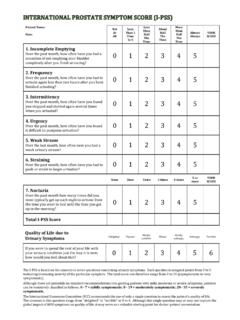Transcription of Kalman Filter Applications - Cornell University
1 Subject MI63: Kalman Filter Tank FillingKalman Filter ApplicationsThe Kalman Filter (see Subject MI37) is a very powerful toolwhen it comes to controlling noisy systems. The basic idea of aKalman Filter is: Noisy data in hopefully less noisy data Applications of a Kalman Filter are numerous: Tracking objects ( , missiles, faces, heads, hands) Fitting Bezier patches to (noisy, moving, ..) point data Economics Navigation Many computer vision Applications Stabilizing depth measurements Feature tracking Cluster tracking Fusing data from radar, laser scanner andstereo-cameras for depth and velocity measurements Many moreThis lecture will help you understand some direct applicationsof the Kalman Filter using numerical examples that will be outlined are:1.
2 Simple 1D example, tracking the level in a tank (this pdf)2. Integrating disparity using known ego-motion (in MI64)Page 1 September MI63: Kalman Filter Tank FillingPredict-Update EquationsFirst, recall the time discrete Kalman Filter equations (see MI37)and the predict-update equations as below:Predict: xt|t 1=Ft xt 1|t 1+BtutPt|t 1=FtPt 1|t 1 FTt+QtUpdate: xt|t= xt|t 1+Kt(yt Ht xt|t 1)Kt=Pt|t 1 HTt(HtPt|t 1 HTt+Rt) 1Pt|t= (I KtHt)Pt|t 1where x:Estimated :State transition matrix ( , transition between states).
3 U:Control :Control matrix ( , mapping control to state variables).P:State variance matrix ( , error of estimation).Q:Process variance matrix ( , error due to process).y:Measurement :Measurement matrix ( , mapping measurements onto state).K: Kalman :Measurement variance matrix ( , error from measurements).Subscripts are as follows:t|tcurrent time period,t 1|t 1previous time period, andt|t 1are intermediate 2 September MI63: Kalman Filter Tank FillingModel Definition ProcessThe Kalman Filter removes noise by assuming a pre-definedmodel of a system.
4 Therefore, the Kalman Filter model must bemeaningful. It should be defined as the situation:Look at the problem. Break itdown to the mathematical basics. If you don t do this, youmay end up doing unneeded the state process:Start with a basic model. It maynot work effectively at first, but this can be refined the measurement process:Analyze how you aregoing to measure the process. The measurement space maynot be in the same space as the state ( , using an electricaldiode to measure weight, an electrical reading does noteasily translate to a weight).
5 The noise:This needs to be done for both thestateandmeasurementprocess. The base Kalman Filter assumesGaussian (white) noise, so make the variance andcovariance (error) meaningful ( , make sure that the erroryou model is suitable for the situation). the Filter :Often overlooked, use synthetic data ifnecessary ( , if the process is not safe to test on a liveenvironment). See if the Filter is behaving as it Filter :Try to change the noise parameters ( Filter ), asthis is the easiest to change. If necessary go back further,you may need to rethink the 3 September MI63: Kalman Filter Tank FillingExample: Water level in tank1.
6 Understanding the situationWe consider a simple situation showing a way to measure thelevel of water in a tank. This is shown in the are trying to estimate the level of water in the tank, which isunknown. The measurements obtained are from the level of the float . This could be an electronic device, or a simplemechanical device. The water could be: Filling, emptying or static ( , the average level of the tankis increasing, decreasing or not changing). Sloshing or stagnant ( , the relative level of the float to theaverage level of the tank is changing over time, or is static).
7 Welch/ Kalman / 4 September MI63: Kalman Filter Tank FillingFirst Option: A Static Model2. Model the state processWe will outline several ways to model this simple situation,showing the power of a good Kalman Filter first is the most basic model, the tank is level ( , the truelevel is constantL=c).Using the equations from Page 2, the state variable can bereduced to a scalar ( , x=xwherexis the estimate ofL).We are assuming a constant model, thereforext+1=xt, soA= 0andFt= 1, for anyt variablesBanduare not used ( , both= 0).
8 3. Model the measurement processIn our model, we have the level of the float. This is representedbyy= value we are measuring could be a scaled measurement( , a 1 cm measurement on a mechanical dial could actuallybe about 10 cm in the true level of the tank). Think of yourpetrol gauge on your car, 1 cm can represent 10 L of petrol!For simplicity, we will assume that the measurement is the exactsame scale as our state estimatex( ,H= 1).Page 5 September MI63: Kalman Filter Tank Filling4. Model the noiseFor this model, we are going to assume that there is noise fromthe measurement ( ,R=r).
9 The process is a scalar, thereforeP=p. And as the process isnot well defined, we will adjust the noise ( ,Q=q).We will now demonstrate the effects of changing these Test the filterYou can now see that you can simplify the equations from Page2. They simplify as follows:Predict:xt|t 1=xt 1|t 1pt|t 1=pt 1|t 1+qtUpdate:xt|t=xt|t 1+Kt(yt xt|t 1)Kt=pt|t 1(pt|t 1+r) 1pt|t= (1 Kt)pt|t 1 Page 6 September MI63: Kalman Filter Tank FillingThe Filter is now completely defined. Let s put some numbersinto this model.
10 For the first test, we assume the true level of thetank isL= initialize the state with an arbitrary number, with anextremely high variance as it is completely unknown:x0= 0andp0= 1000. If you initialize with a more meaningfulvariable, you will get faster convergence. The system noise wewill choose will beq= , as we think we have an accuratemodel. Let s start this :x1|0= 0p1|0= 1000 + hypothetical measurement we get isy1= (due to noise).We assume a measurement noise ofr= :K1= ( + ) 1= |1= 0 + ( 0) = |1= (1 ) = you can see that Step 1, the initialization of 0, has beenbrought close to the true value of the system.

